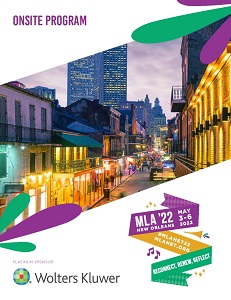Back
Paper: Research Abstract
Information Management
Session: Papers Virtual Session 8
The Continued Problem of Uniform Resource Locator Decay: an Updated Analysis of Health Care Management Journal Citations
Friday, April 29, 2022
3:00 PM – 3:15 PM CT

Amber Burtis
Assessment & User Experience Librarian
Southern Illinois University Carbondale
Susan Howell
Cataloging and Metadata Librarian
Southern Illinois University
Carbondale, Illinois
Presenter and Author(s)
Objectives: This study updates a 2009 study which examined uniform resource locator (URL) decay in health care management journals to determine whether continued URL availability relates to publication date, resource type, or top-level domain. Research has primarily addressed URL accessibility at one snapshot in time or URL accessibility at one snapshot in time for a specific discipline or specific journal. A smaller number of studies have looked at content changes in a sample of URLs but no other published studies have followed a similar methodology to this study by comparing data from a specific discipline over two distinct time periods.
Methods: The URLs of web-based resources cited in articles published in five health care management source journals from 2016 to 2018 were compiled in a Microsoft Access database. In total, 10,319 web-based resources were collected. Information about the resource (source journal, issue date, type of resource, URL, URL domain extension, availability) was entered into the database. Each web-based resource was checked to determine if the URL was active or inactive. Statistical analyses were performed to determine if there were statistically significant differences by publication date, resource type, or top-level domain or across the two study periods.
Results: There were statistically significant differences in URL availability across resource type and top-level domain. Websites were the resource type with the highest rate of decay. Domains with the highest rate of decay were .com and .net and the lowest rate were .edu and .gov. As expected, the older the citation, the higher the rate of decay. The number of URLs cited increased over 500% since the original 2009 study even though both studies examined a sample of three years of the same five journals. The overall rate of URL decay decreased from 49.3% to 36.1% between studies.
Conclusions: An analysis of differences in findings between the two study periods found that URL decay in health care management journals has decreased in the last 15 years. Still, URL decay does continue to be a problem. Interestingly, health services policy research journals had a lower rate of decay than practitioner-oriented journals (34.8% vs. 51.7%). Authors, publishers, and librarians should work collaboratively to promote the use of digital object identifiers and web archiving as a solution to this problem, perhaps by studying and replicating efforts used by health services policy research journals to increase continued URL availability.
Methods: The URLs of web-based resources cited in articles published in five health care management source journals from 2016 to 2018 were compiled in a Microsoft Access database. In total, 10,319 web-based resources were collected. Information about the resource (source journal, issue date, type of resource, URL, URL domain extension, availability) was entered into the database. Each web-based resource was checked to determine if the URL was active or inactive. Statistical analyses were performed to determine if there were statistically significant differences by publication date, resource type, or top-level domain or across the two study periods.
Results: There were statistically significant differences in URL availability across resource type and top-level domain. Websites were the resource type with the highest rate of decay. Domains with the highest rate of decay were .com and .net and the lowest rate were .edu and .gov. As expected, the older the citation, the higher the rate of decay. The number of URLs cited increased over 500% since the original 2009 study even though both studies examined a sample of three years of the same five journals. The overall rate of URL decay decreased from 49.3% to 36.1% between studies.
Conclusions: An analysis of differences in findings between the two study periods found that URL decay in health care management journals has decreased in the last 15 years. Still, URL decay does continue to be a problem. Interestingly, health services policy research journals had a lower rate of decay than practitioner-oriented journals (34.8% vs. 51.7%). Authors, publishers, and librarians should work collaboratively to promote the use of digital object identifiers and web archiving as a solution to this problem, perhaps by studying and replicating efforts used by health services policy research journals to increase continued URL availability.

.png)

